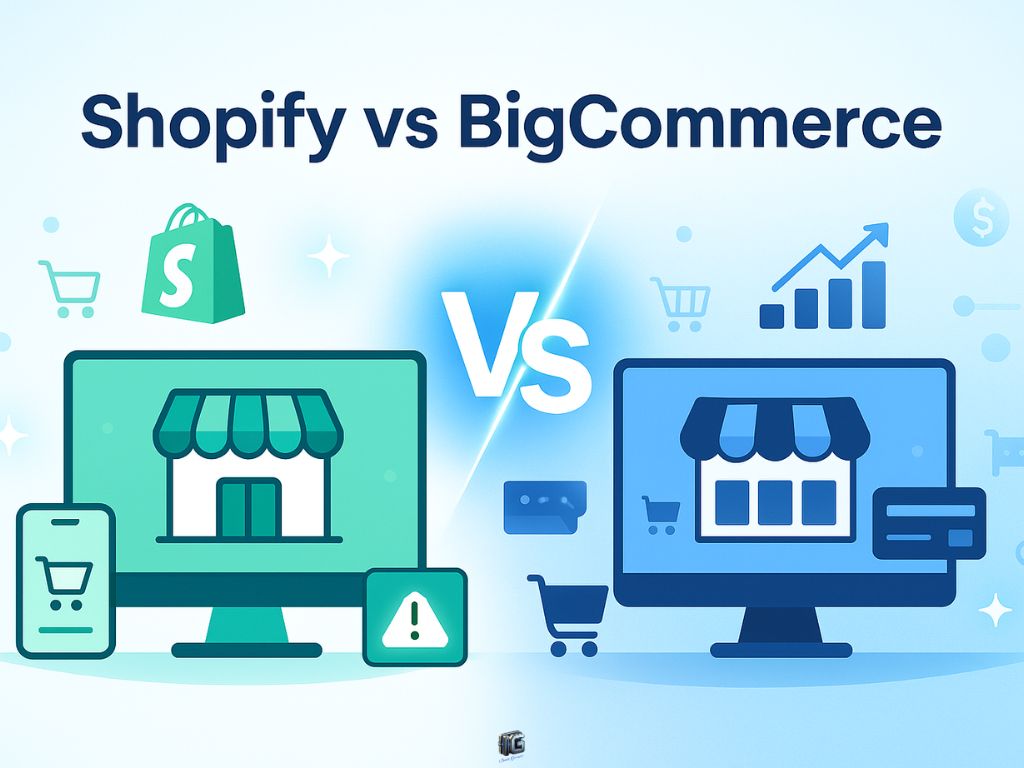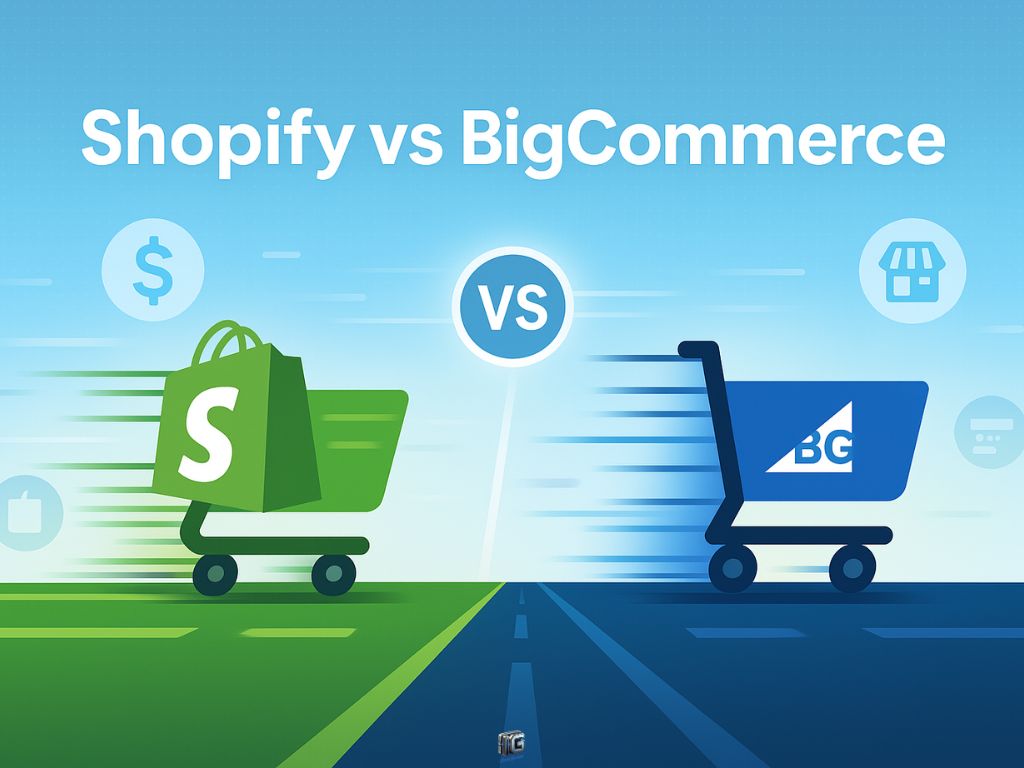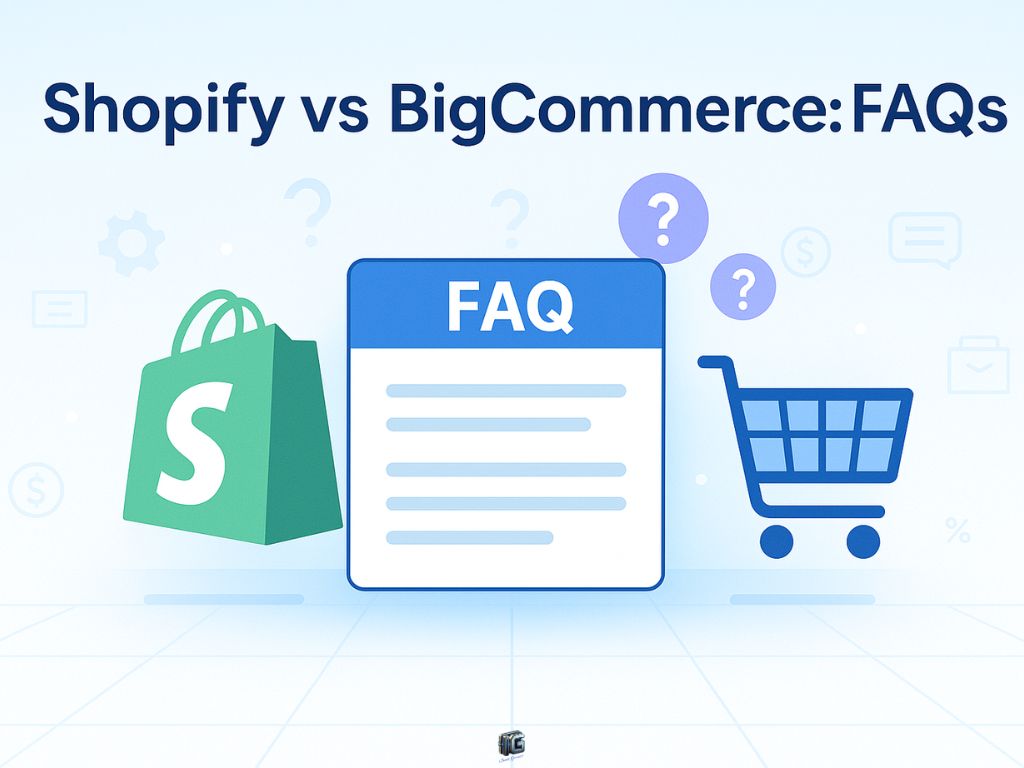Introduction
Shopify vs BigCommerce. Two of the biggest names in eCommerce. Two very different paths to building your online empire.
Shopify promises speed, simplicity, and stunning store designs. BigCommerce fights back with raw built-in power, better scalability, and no hidden fees.
But which one actually gives you the better shot at success in 2025?
In this brutally honest comparison, we’re breaking down every critical difference — pricing, features, ease of use, SEO, and scalability — so you can make the smartest choice for your business before wasting time or money.
Ready to find out who really wins?

Key Takeaways
- Shopify makes it faster and easier to launch a beautiful store, but costs can skyrocket with paid apps.
- BigCommerce gives you more built-in features and lower long-term costs, but has a steeper learning curve.
- Shopify is ideal for entrepreneurs focused on design and speed.
- BigCommerce is better for scaling businesses serious about SEO and growth.
- Choosing the wrong platform can cost you thousands in hidden fees or missed opportunities — we’ll show you which fits your goals.
Shopify vs BigCommerce: A 60-Second Overview
Shopify is built for speed, simplicity, and stunning design. If you want to set up a professional online store without technical headaches, Shopify is made for you. It’s the go-to choice for entrepreneurs who care about fast setup, beautiful themes, and an easy-to-learn dashboard.
BigCommerce is built for strength, scalability, and control. If you’re planning for serious growth — more products, bigger SEO ambitions, fewer hidden costs — BigCommerce gives you more built-in firepower. It’s best suited for brands that want long-term flexibility without getting trapped in app fees.
Bottom Line:
- Choose Shopify if you want fast, beautiful, beginner-friendly stores.
- Choose BigCommerce if you want serious growth potential, stronger SEO, and lower costs over time.
Pricing: Which Platform Costs You More Over Time?
At first glance, Shopify and BigCommerce seem neck-and-neck.
- Shopify starts at $39/month.
- BigCommerce starts at $39/month.
Sounds like a tie, right? Not even close.
Shopify charges you extra transaction fees unless you use their own payment system (Shopify Payments). If you want to use PayPal, Stripe, or anything else, Shopify slices off up to 2% per sale.
BigCommerce? No transaction fees. Ever. Use any payment gateway you want without penalties.
And the trap doesn’t end there.
Shopify relies heavily on paid apps to add basic features — real-time shipping rates, advanced SEO controls, custom checkout options. BigCommerce includes most of those features out of the box.
Translation:
- Shopify looks cheaper at signup.
- BigCommerce stays cheaper as you grow.
If you’re scaling past a few dozen sales a month, Shopify’s hidden costs stack up fast — and can easily double your monthly bill.
Brutal Truth: Shopify wins on entry-level simplicity. BigCommerce wins on total cost of ownership.
Pricing: Which Platform Costs You More Over Time?
At first glance, Shopify and BigCommerce seem neck-and-neck.
- Shopify starts at $39/month.
- BigCommerce starts at $39/month.
Sounds like a tie, right? Not even close.
Shopify charges you extra transaction fees unless you use their own payment system (Shopify Payments). If you want to use PayPal, Stripe, or anything else, Shopify slices off up to 2% per sale.
BigCommerce? No transaction fees. Ever. Use any payment gateway you want without penalties.
And the trap doesn’t end there.
Shopify relies heavily on paid apps to add basic features — real-time shipping rates, advanced SEO controls, custom checkout options. BigCommerce includes most of those features out of the box.
Translation:
- Shopify looks cheaper at signup.
- BigCommerce stays cheaper as you grow.
If you’re scaling past a few dozen sales a month, Shopify’s hidden costs stack up fast — and can easily double your monthly bill.
📊 Shopify vs BigCommerce: Pricing Comparison
| Feature | Shopify | BigCommerce |
| Starting Price | $39/month | $39/month |
| Transaction Fees | Up to 2% (unless using Shopify Payments) | None |
| Included Features | Many features require paid apps | Most features built-in |
| Total Cost Over Time | Higher with apps and extra fees | Lower, more predictable |
Brutal Truth: Shopify wins on entry-level simplicity. BigCommerce wins on total cost of ownership.
Ease of Use: Which Platform Makes Selling Simpler?
If you’re betting your business on an online store, the last thing you need is a platform that feels like decoding rocket science.
Shopify wins here — and it’s not even close.
The moment you sign up, Shopify pulls you into a clean, simple dashboard. Adding products? Drag and drop. Setting up payments? A few clicks. Launching a live store? Done by dinner.
BigCommerce feels… heavier.
While it offers way more native tools, its dashboard is less intuitive. New users often find themselves digging through settings, toggling advanced options, and Googling what half the features even mean.
In short:
- Shopify is like assembling Ikea furniture with clear instructions.
- BigCommerce is like building a car from scratch — powerful but overwhelming if you’re not ready.
If you’re a first-timer or value speed over complexity, Shopify makes your life way easier. If you love control and don’t mind a learning curve, BigCommerce eventually rewards you with more flexibility — but you’ll pay with your time upfront.
Features: Who Gives You More Tools to Scale?
If you’re serious about growth, BigCommerce loads you up with firepower right out of the box.
Built-in SEO tools. Real-time shipping quotes. Multi-currency selling. Product filtering. Gift cards. Abandoned cart recovery. No endless app installs. No nasty surprises on your bill.
Shopify keeps it clean and polished — but the second you want to stretch beyond basic selling, you’re heading to the App Store with your wallet open.
Advanced SEO settings? That’ll cost you. Customizable checkout? Another app. Even something as simple as real-time shipping rates usually means extra monthly fees.
BigCommerce bakes growth tools directly into the platform. Shopify rents them to you later — at a markup.
Bottom Line:
- Shopify wins for startups focused on fast setup and beautiful storefronts.
- BigCommerce wins for scaling brands who hate being nickeled-and-dimed at every step.

Design and Customization: Which One Wins on Style?
When it comes to visual impact, Shopify owns the runway.
Their themes are sleek, modern, and ridiculously easy to customize — even if you’ve never touched a line of code.
Most of Shopify’s free templates look better than BigCommerce’s paid ones.
And if you spring for a premium theme? Your store will look like a million-dollar brand, even if you’re selling $20 t-shirts.
BigCommerce tries hard — and it’s improving fast — but it still lags behind.
Their theme selection is smaller, and while they offer decent design flexibility, you’ll likely need to get your hands dirty with some code if you want a truly custom look. Non-designers will find BigCommerce less forgiving.
In short:
- Shopify hands you a polished storefront on a silver platter.
- BigCommerce hands you a toolbox — and expects you to know how to use it.
If you want to move fast and look like a pro with minimal effort, Shopify wins by a mile. If you value deep customization and don’t mind getting technical, BigCommerce can still build you something powerful — but expect more work.
Scalability and Performance: Which Platform Handles Growth Better?
Launching a store is easy. Scaling it into a powerhouse? That’s where the cracks start to show.
BigCommerce is built to scale without blinking.
It handles massive product catalogs, high-traffic surges, and international selling — all without forcing you to upgrade to some overpriced enterprise plan. You get multi-currency support, robust APIs, and advanced shipping options baked right into the standard plans.
Shopify can scale too, but you’ll hit glass ceilings faster than you think. Want more control over checkout? You’ll need Shopify Plus — starting at around $2,000/month. Handling serious international expansion? Get ready for extra fees and app dependency.
Bottom Line:
- BigCommerce is engineered for businesses that plan to grow aggressively and globally.
- Shopify is optimized for small-to-medium brands — unless you’re ready to pay enterprise-level prices to break through its limits.
Brutal truth: If you’re dreaming of 7- or 8-figure growth, BigCommerce gives you more firepower for less money.
Customer Support: Who Has Your Back When Things Break?
When your store crashes at 2 AM, you’ll find out real fast what kind of platform you picked.
Both Shopify and BigCommerce offer 24/7 support — live chat, phone, and email.
But there’s a difference they don’t put on the sales page:
Shopify’s support is faster, friendlier, and more beginner-focused.
Their team is trained to guide first-time store owners through even the simplest issues without making you feel dumb. Getting help setting up a payment gateway or tweaking your theme? Expect fast, polite answers — often within minutes.
BigCommerce’s support feels more technical.
It’s great if you already know what you’re doing. Developers and power users get solid help for complex issues. But if you’re a beginner asking a basic setup question? Expect slower responses, longer explanations, and more links to “help articles” rather than hands-on guidance.
Bottom Line:
- Shopify wins for beginners and fast help.
- BigCommerce wins for experienced users who can speak tech fluently.
If you want hand-holding, Shopify is your safety net. If you can troubleshoot like a pro, BigCommerce gives you the depth — but expects you to work harder for it.

Frequently Asked Questions (FAQs)
Is Shopify better for beginners?
Yes. Shopify’s dashboard is cleaner, easier to navigate, and designed for non-technical users. It’s the fastest way to launch if you’re new to eCommerce.
Does BigCommerce charge transaction fees?
No. BigCommerce never charges transaction fees, even if you use third-party payment gateways like PayPal or Stripe.
Which platform has better SEO tools?
BigCommerce. It offers deeper built-in SEO customization without forcing you to install apps. You have more control over URLs, metadata, and page structure right out of the box.
Can you migrate from Shopify to BigCommerce later?
Yes. You can migrate, but it’s technical. Expect some work moving your products, customer data, and design. There are apps and services that can help if you decide to switch platforms down the road.
Which platform is better for international selling?
BigCommerce. It offers native multi-currency support and more advanced international features without needing expensive third-party apps.
Is Shopify or BigCommerce cheaper long-term?
BigCommerce usually wins. Shopify starts cheap but becomes expensive once you add essential paid apps and deal with transaction fees.

Final Verdict: Which Platform Should You Choose?
Choosing between Shopify and BigCommerce isn’t just about features — it’s about your ambition.
If you want to launch fast, look like a million bucks, and avoid tech headaches, Shopify is your rocket ship. You’ll sacrifice a little flexibility (and pay for extras later), but you’ll move fast and look good doing it.
If you’re building for the long haul — more products, more traffic, more markets — BigCommerce is your war machine. It’s heavier upfront, but gives you the tools to scale past 7 or 8 figures without bleeding money into apps and upgrades.
Here’s the brutal breakdown:
- Pick Shopify if you value simplicity, design, and a fast start.
- Pick BigCommerce if you value scalability, SEO, and total control.
Both platforms are powerful. Both can build you an empire. But only one matches the way you want to win. Choose wisely.
Before you choose, read our ClickFunnels vs Shopify comparison for a smarter decision.
0 Comments